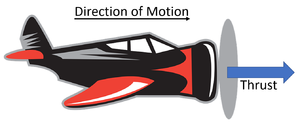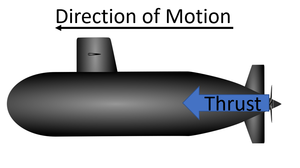Contents
Key Stage 3
Meaning
Thrust is a force provided sending a fluid back to propel the object forward.
About Thrust
- Thrust is a force so it is measured in Newtons.
- Thrust is a contact force because a turbine or propeller must be in contact with the fluid being used.
- Thrust can cause a vehicle to accelerate and can act to counter air resistance and friction to keep a vehicle travelling at a constant speed.
NB: The fluid does not need to 'push' against any other material already there. The force is provided because sending mass in the opposite direction to the direction you want to go.
Example
| The plane produces thrust by sending air backwards very quickly using the propeller. | The submarine produces thrust by sending water backwards very quickly using the propeller. |
Key Stage 4
Meaning
Thrust is a force provided sending a fluid back to propel the object forward.
About Thrust
- Thrust is a force so it is measured in Newtons.
- Thrust is a contact force because a turbine or propeller must be in contact with the fluid being used.
- Thrust can cause a vehicle to accelerate and can act to counter air resistance and friction to keep a vehicle travelling at a constant speed.
NB: The fluid does not need to 'push' against any other material already there. The force is provided because sending mass in the opposite direction to the direction you want to go.
- Thrust acts by applying a force to the fluid around it to accelerate the fluid backwards. The fluid provides a reaction force to push the object forwards.
Example
| The plane produces thrust by sending air backwards very quickly using the propeller. The air provides a reaction force equal in magnitude but opposite in direction causing the plane to accelerate. | The submarine produces thrust by sending water backwards very quickly using the propeller. The water provides a reaction force equal in magnitude but opposite in direction causing the submarine to accelerate. |

